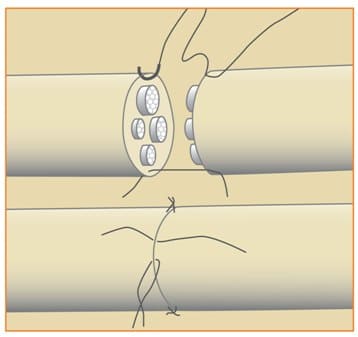Description
Nerve repair is required after a nerve is injured in such a way that it will not recover on its own. Nerves are bundles of fibers that carry messages between the brain and the rest of the body.
Some nerves carry messages from the brain to muscles to make the body move. Other nerves carry messages about pain, pressure, or temperature from the body to the brain.
Nerves run all over the body and can be injured, resulting in problems with sensation or movement.

Figure: Some nerve injuries can be repaired by bringing the two ends of the nerve together and using small stitches to hold them together.
Causesh
Nerve damage can occur in many ways. These can include a sharp cut, a crush, or a tear (avulsion). This can happen from trauma, such as a car accident or being cut with a knife.
Nerves can also be accidentally injured during medical procedures or surgeries, and this is known as iatrogenic injury. A nerve can also be invaded by a tumor which requires removal, resulting in nerve damage.
Signs and SymptomsH
When nerve damage occurs, the nerve can no longer carry messages. For example, if a sensory nerve is injured, you may not be able to feel a particular area of your skin. If a motor nerve is injured, you may have weakness or inability to perform certain movements.
Nerve damage can also cause pain, either at the site of injury or anywhere along the course of the nerve.
Doctor Examination
To determine whether you have nerve damage, your doctor will take a history and do an exam. He or she will ask about what you are experiencing and how long you have had symptoms. If your doctor is concerned you havenerve damage, they may order a Nerve Conduction Study (NCS) or Electromyography (EMG). These tests are done by a neurologist and help determine if your nerves are working abnormally.
- The finger at the middle joint cannot be straightened and the finger tip cannot be bent.
- Swelling and pain occur and continue on the top of the middle joint of the finger.
Treatment
Some nerve injuries get better on their own, but more severe injuries can require nerve repair or other interventions. A nerve repair is not like an artery or vein repair, where blood starts flowing immediately. A nerve repair only recreates the tunnel for the nerve. Then, the nerve fibers have to grow back through that tunnel. This is why nerve repairs are described as “like planting a tree”. Until the nerve re-grows from the point of injury to the target muscle or skin, the nerve will not function normally.
In the case of a sharp nerve injury involving only a short segment of nerve, a direct repair may be possible. In this case, a surgeon will bring the two ends of the nerve together and use small stitches to hold the nerve ends together (Figure 1).
If the nerve has been crushed, torn, or invaded by tumor, direct repair may not be possible. In this case, your surgeon may use a nerve graft. Nerve graft is a piece of nerve, either from another part of your body or from a cadaver. This piece of nerve serves as a bridge between the two ends of the nerve.
Nerve fibers grow slowly, about one millimeter per day or one inch per month. It may take many months for a nerve to grow from where it is injured all the way to its target. During the healing time, you might have pain or “pins and needles” sensation along the course of the nerve. You may need therapy to help keep your joints moving and your pain controlled while your nerve is growing.
If it has been a long time since your nerve damage, nerve repair may not be possible. If a muscle does not receive a signal from a nerve for a long time, it can stop responding altogether. This usually happens after 18 months without a signal but depends on the kind of nerve damage, the age of the patient, and other factors. If the nerve is not repairable, your doctor may discuss other options such as nerve or tendon transfers to help you regain function.
